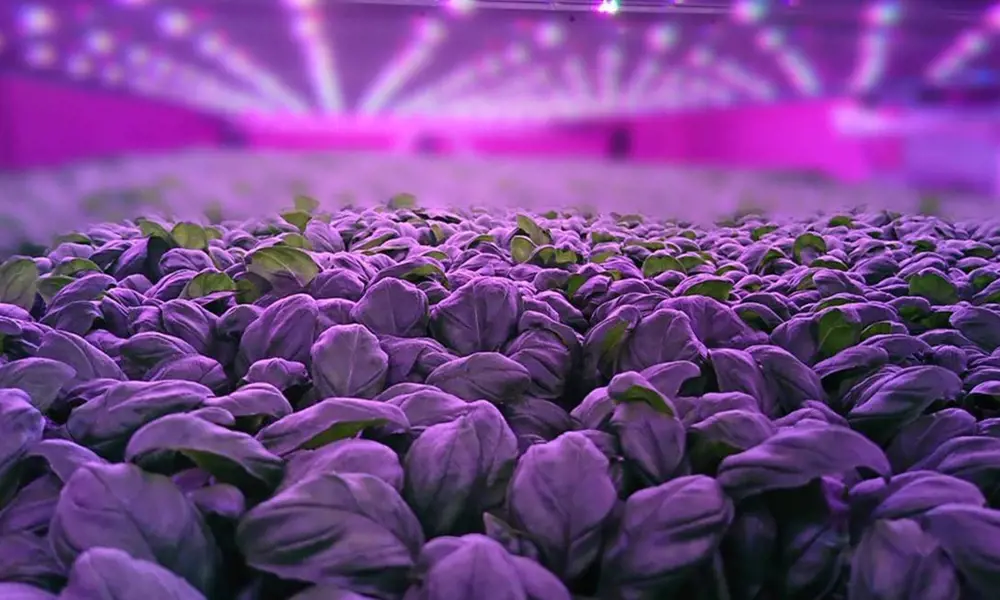
Vertical farming for future growth
Current farming methods are often wasteful in terms of space, water and money. However, vertical farms, which grow crops in trays stacked in tall towers, could help to reduce food waste by up to 90%. They would help to grow produce locally and on demand, and the growing process could allow farmers to control the environment whatever the season, changing the intensity and length of exposure to light, temperature, humidity, water irrigation, nutrients and carbon dioxide levels to create optimum conditions in which crops can thrive. In the future, these vertical towers could replace greenhouses at about half the cost, and with increases in savings and a reduction in space used.
vertical farms, which grow crops in trays stacked in tall towers, could help to reduce food waste by up to 90%
This agricultural revolution is not a new concept; in 1909, Life magazine published one of the earliest drawings of a vertical farm. In the 1950s and 60s, prototypes were first produced. In 1999, the idea was reintroduced by Dickson Despommier, a professor of environmental health sciences and microbiology at Columbia University, who speculated that a 30-floor farm could provide food for 50,000 city-dwellers. While many of his ideas have been challenged, vertical farms are now a reality in the US, Europe and Asia, where they are popular in cities where space is at a premium. In 2016, there were 2.3 million square feet of indoor farms across the globe, and this is expected to grow to between 8.5 million square feet and 16.55 million square feet by 2021. However, the UK’s vertical farm industry has previously been described as ‘underdeveloped’ as only a few crops, including lettuces, are grown in a few operational vertical farms. But the UK does have Europe’s largest vertical farm owned by Jones Food Company, which is 17 storeys high.
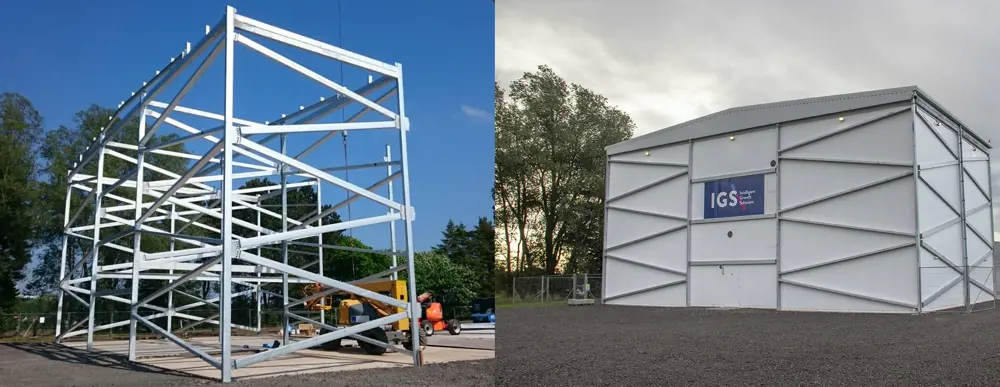
The Dundee farm is housed in a purpose-built superstructure that has insulated cladding to protect crops from the external environment. The structure has space for four growth towers © Intelligent Growth Solutions
Scotland’s first vertical farm, operated by Intelligent Growth Solutions (IGS) at the James Hutton Institute in Dundee, uses new technologies to overcome challenges presented by power and labour costs, which have inhibited the sector’s expansion so far. IGS claims its growth tower is the most advanced vertical farm design developed to date because it allows experts to monitor and control growing conditions, learning from mistakes and improving the environment using artificial intelligence (AI). A key breakthrough for the system has been in the way that it manages power consumption, particularly through the development of LED lighting, which has reduced energy costs dramatically. The demonstration facility opened in August 2018 and the company expects 95% of its technology to be exported, with the first installations already being deployed in the US.
The idea is that a commercial farm could be controlled via an app and the system managed by engineers instead of farmers having to get to grips with extra cables and computers
The current farm has space for four growth towers, each with a growing area of approximately 310 square metres, but only occupies a footprint of 41 square metres. The towers are individually housed in a standard steel frame warehouse building with insulated cladding walls to provide isolation from the external environment. Each tower, which is currently growing a range of fast-growing herb and leaf crops, has standalone ventilation and irrigation closed-loop systems that automatically sterilise and recycle air and water so that the only regular inputs that the system needs are power, seed, nutrients, carbon dioxide and harvested rainwater. Within each tower, all important parameters – light, heat, humidity, water, nutrients, and crop movement – are controlled by industrial programmable logic controllers (PLCs), which are computers that run on an architecture that does not need unpredictable updates. The Omron SYSMAC PLCs use feedback from sensors distributed throughout the tower and systems that is transferred to a cloud-based control system in real time, allowing experts to constantly monitor and adjust the growth environment to optimise production. This system uses AI algorithms that analyse the growth results, learn from production and calculate the best way to boost output by suggesting tweaks to the growing environment. The idea is that a commercial farm could be controlled via an app and the system managed by engineers instead of farmers having to get to grips with extra cables and computers.
The benefits of vertical farming
🌽 How vertical farms save space, resources and money while increasing food quality and security
- Good for the UK: the UK’s population is growing at about 0.6% a year and the country is expected to face a shortfall of two million hectares of farmable land by 2030, making vertical farms a practical, space-saving solution.
- Crops are grown locally: this produces near-to the demand for food, so reduces food miles, cutting costs. Salad crops and ground fruit would be grown in vertical farms in the short term. The method of farming also increases food security, by reducing dependency on imports.
- Food is better quality: proponents of vertical farming say the method improves the appearance of food, as well as its nutritional qualities and taste, which remain consistent year round because of growing conditions. Crops are disease-free, eliminating the need for pesticides, while semi-hydroponic techniques eliminate the need for washing, reducing contamination.
- Natural resources are saved: vertical farms have a much smaller footprint than fields, freeing up farmland for alternative use, such as energy crops or for conservation. Furthermore, the ability to recycle water reduces its consumption by 90% compared to field growing and makes it around 10% more water efficient than greenhouse growing.
- Saving money: the reducing cost and improving electrical efficiency of LEDs, compression of the value chain, production matched to consumer demand, reducing wastage and integrated automation reduced labour costs mean vertical farming can cut costs.
Managing power consumption
To overcome the challenge of energy consumption, IGS designed a power-management system that flexes with the grid in real time, so that it responds to external influences such as grid stability and power availability, importing power when cheap or exporting it when costly. This means that the facility effectively acts similarly to a large battery where the energy is converted into food. The use of industrial Omron SYSMAC PLCs within the facility allows automatic recovery from power loss events and means that individual towers and sites get the power they need, meaning that none of the systems need to be reset, reprogrammed or manually repositioned. Each tower has a baseline power consumption of 60 kilowatts (kW), which can be rapidly increased to 105 kW or reduced to 30 kW for short periods to optimise grid stability, while the impact on growing is managed by the control system’s AI elements.
Heating and air conditioning can be a drain on power resources. However, the watering, heating, ventilation and air conditioning systems are also closed loop, which minimises their impact. The design also reduces the need for HEPA (high efficiency particulate air) filtration to clean large volumes of incoming air, and the potential heating and/or cooling of this air depending on location and season. The air is sterilised by UV filtration technology, similar to clean rooms, and heated by the waste heat from LEDs that are used to mimic the sun. Standard industrial chillers and cooling coils cool and dehumidify the air, before it is passed back over the LEDs for preheating and then returned to the crop. Carbon dioxide can be added to this loop when required too.
To overcome the challenge of energy consumption, IGS designed a power-management system that flexes with the grid in real time
Lighting uses approximately 70% of the system’s power, which is not surprising as there are 1,140 LEDs per tray. To improve the efficiency of power transmission to the lights, IGS developed a power distribution system for driving the LEDs, which takes an industrial three-phase power supply, transforms it to a safe voltage level and transmits it to each individual tray within the tower using tubes rather than cables. The use of tubes rather than cables improves transmission efficiency because of the skin effect in cables. When electrical AC power is transmitted through a cable, magnetic effects cause the current to be forced to the outside ‘skin’ of the conductor. This reduces the useful cross-sectional area of the cable. The presence of conductive material in the centre of the cable gives rise to these magnetic effects, so the use of tube rather than cable actually reduces the cause of skin effect, allowing better distribution of current through the remaining conductor material and improving transmission efficiency. This effect is driven by the AC frequency and conductor diameter, with a 9 millimetre cable diameter being the key threshold parameter for efficiency with 50 hertz supplies. Due to the safe low voltage used to transmit power to the trays the current and cable diameter is large, leading to significant advantage in the use of tubes over cables. A side effect of this is that aluminium tubes are also much cheaper and lighter than suitable copper cables. The retention of three-phase AC power to a tray level further reduces losses and provides inherent phase balancing, eliminating the need for costly and inefficient filtering and power factor correction, as well as the use of capacitors for single phase conversion. These measures contribute to a 5% to 10% increase in driver efficiency.
Lighting up the farm
Many indoor growing facilities use red and blue lights to nurture plants, after scientists demonstrated that not all wavelengths of light contained in sunlight are needed for effective growth. More recent research has shown that varying the spectrum used at different stages of growth can also offer a significant improvement in the crop yield. This system uses four different wavelengths of red, blue and green LEDs and has experimented with others including far red and white. The LEDs are fitted in clusters, with each cluster containing all types of LED. The team then varies the light intensity and/or dimming for each individual colour to control the spectrum. This dimming is controlled by its LED driver boards, which are wirelessly connected to the PLC controller. The ability to vary the spectrum used has been a key focus for IGS and the company says that the ability to control the spectrum or pulse width modulation (PWM) and intensity to simulate solar radiation is unique among vertical farms. Each wavelength can be turned on or off or dimmed via PWM, linear dimming or a combination of both. However, while the facility has this ability, the precise optimal mix of light for each crop and stage of growth is not well understood, so the team is using AI to measure and understand the crops’ progress, in order to accelerate learning in this area. Its observations within a controlled environment are challenging some of the current thinking in terms of important wavelengths and data will be used at the farm to further boost plant production.
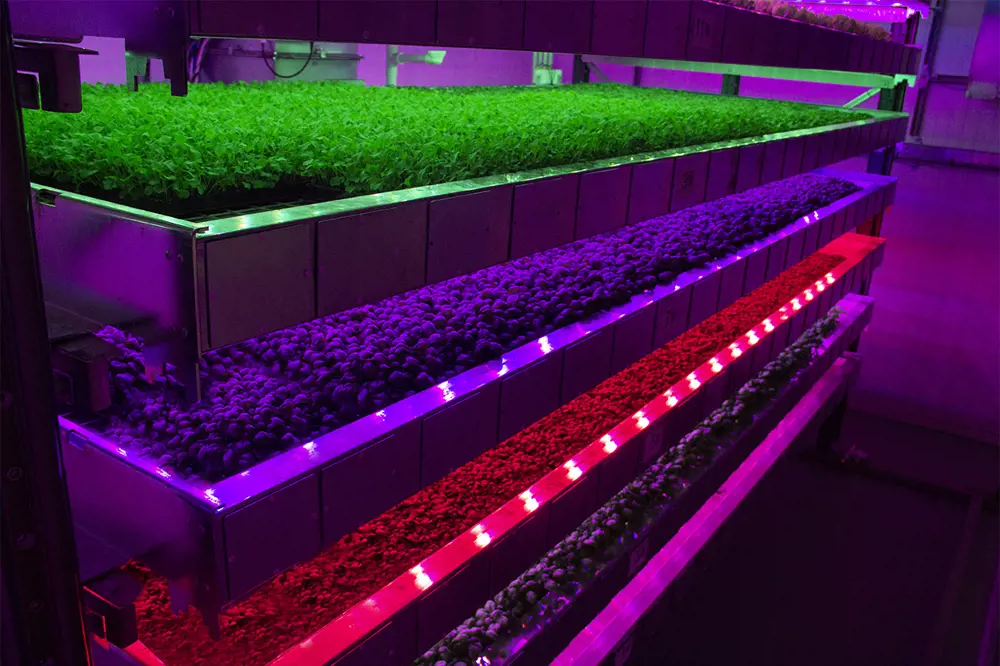
Different coloured LEDs are used to nurture the plants at different stages of growth, with the intensity increasing and dimming when needed © Intelligent Growth Solutions
For example, while research has shown that green light does not directly contribute to photosynthesis to any great degree, IGS has shown that adding green light, particularly at certain stages of growth, increases both crop yield and quality. Its scientists believe the green light is acting as a trigger to improve photosynthetic processes, rather than the dominant effect being a contribution to photosynthesis. Similarly, the company uses far red light because it stimulates stem growth, rather than directly contributing to photosynthesis. This means that doses of far red light at certain phases of growth can be used to alter the plant’s shape or structure by promoting stem growth in a controlled manner. The challenge is not allowing the plants to grow excessively tall and leggy, so using AI to learn the effects of far red light at different stages of growth allows IGS to produce crops suitable for market with the minimum energy input, by only using far red light where it has most effect.
The challenge is not allowing the plants to grow excessively tall and leggy, so using AI to learn the effects of far red light at different stages of growth allows IGS to produce crops suitable for market with the minimum energy input, by only using far red light where it has most effect.
Alongside the spectrum of light used, the method of how it is delivered to crops could affect how well they grow, and the facility can vary both intensity, through linear dimming or PWM, and PWM infinitely in 0.01% increments over all wavelengths simultaneously and maintain 90% electrical efficiency from grid to LEDs. As biological systems, plants have response times to stimuli in the same way as we do. One such response is the time taken to activate photoreceptors within the plant to perform photosynthesis, as well as the time to shut down again once it has gone dark. This means that plants are not as efficient as they could be in performing photosynthesis and that a pulsing light regime could be used with a pulse duration long enough to keep the plant photosynthetically active. Not only would this boost the plants’ efficiency at converting water, carbon dioxide and light energy into glucose and oxygen, but it could mean that less light is needed overall for the same growth result, potentially benefiting the farmer and saving money. Currently, this is not a proven field and scientists are not sure what the mechanism is that manages the photosynthesis response, but IGS’s initial work shows that similar yields can be produced by pulsing the same intensity of light as when it is on continuously, which means the crop is producing the same yield for less light photon input. IGS has reported promising initial results with the system and it is a further reason for the AI control to enable optimisation.
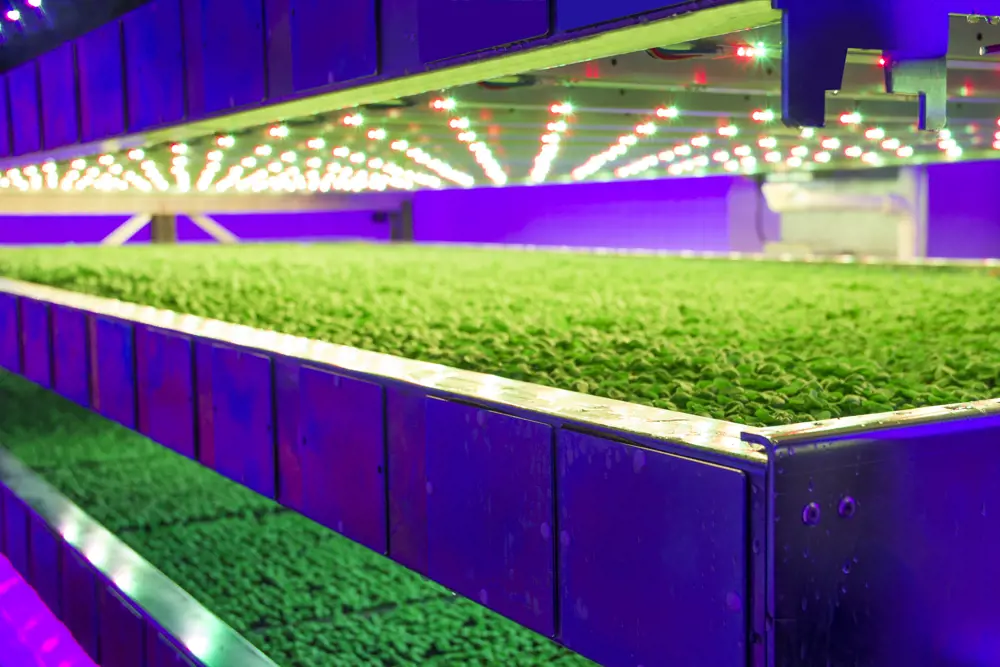
Vertical farms are ideal for crops that are usually grown in greenhouses, such as salad vegetables, herbs and strawberries © Intelligent Growth Solutions
Money matters
The UK’s agri-food supply chain accounts for an annual turnover of £96 billion with revenues of £10 billion, accounting for 6.4% of the UK’s gross value added according to a Defra report published in 2018. The agri-tech industry, supporting farmers and growers with machinery and other kinds of technology, is a multibillion pound sector in which the UK has a 4% to 5% share of the world market. Vertical farming technology could potentially make the UK a leader in this area.
Farmers worldwide face a common set of challenges: population growth, dwindling land, water and energy resources, climate change, and the need to increase efficiency and lower costs. It is hoped that vertical farming will play an important role in tackling these problems. Niall Skinner, Senior Mechanical Engineer at IGS, said that economic benefits include improved yield and reduced wastage for each crop produced. For example, a typical glass house growing basil produces about 30 kilograms per square metre a year, but the vertical farm produces almost double. The technology allows a year-round growing season, which could mean eating strawberries in winter is less environmentally damaging than flying them in from abroad. However, it is difficult to calculate energy and carbon savings, because there are so many factors that determine the cost of production. Douglas Elder, Product Manager at IGS, said the cost of power is the biggest factor because it is determined by scale, location and power generation technique. However, the company produces two to three times the amount of greenhouse-grown crops that require supplemental lighting heating and cooling, putting its production costs per kilogram in the same range.
It is anticipated that vertical farms would be built near cities and/or distribution hubs, so there would be fewer transport costs and a reliable supply because farmers would be less dependent on the weather, potentially saving large amounts of money by avoiding crops spoiled by drought or frost. While the amount farmers save on buying pesticides is unlikely to cover the cost of power for lighting, it will help. Elder said that critics should also consider a massive reduction in wastage through improved regularity of supply and predictability for the retailer, meaning fewer losses. Smart vertical farms could also cut farmers’ utility bills, thanks to the ability to minimise power costs through grid balancing or flexing (especially at larger scale) and use water more sparingly and effectively. Farmers could also save money when buying or renting land because vertical farms have a much smaller footprint.
It is anticipated that vertical farms would be built near cities and/or distribution hubs, so there would be fewer transport costs and a reliable supply because farmers would be less dependent on the weather, potentially saving large amounts of money
However, much like other agri-tech equipment, a vertical farm would be a huge investment. One way to overcome this might be to rent them, much as farmers tend to lease tractors and combine harvesters. IGS has not ruled this out and says its software and support services will be offered on a subscription basis to allow customers to access the latest developments. However, it envisages farmers spending on a vertical farm upfront could recoup their investment in two to four years, thanks to better efficiency and higher crop yields. IGS says this estimate is dependent on a grower’s ability to successfully establish the necessary supply chain.
However, if the investment was readily available, farmers could grow their vertical farms as the system is designed to be scaled, with all elements being modular to allow additions at any time. The towers and control system are fully automatic, and the design allows for as much or little automation outside of this as desired by the farmer or local economics. It is anticipated that most commercial facilities consist of 20 growth towers or more, but vertical farms could be as small as two towers. The growth trays are all returned to the base of the towers for planting, watering, fertigation, harvesting and monitoring, which is designed to work with existing automated harvesting equipment or can simply be removed by hand. Its system has also been designed to self-monitor and provide predictive maintenance capabilities to cut both maintenance costs and labour, providing work schedules for maintenance staff to verify that tasks have been completed. The systems engineering approach adopted in design means that there is a large degree of spares commonality and so the spares inventory for even a large facility can be small.
The future is vertical
While vertical faming is not expected to replace conventional farming, it is expected to form part of the solution for feeding growing cities and meeting the challenge of food security. We could be eating more fruit and veg grown in indoor farms here in the UK, as IGS aims to have the first commercial farms in operation by late 2019. According to Skinner, the technology will focus more on market expansion than replacing traditional farms, partly because not all crops can be grown in an indoor environment. While arable crops are not suited to these systems because they need broad acre production to reach the volumes required, vertical farms are perfect for produce such as salad vegetables and ground-fruit crops such as strawberries. Elder states that the company’s controllable lighting technology may also be suited to growing exotic crops such as vanilla, but this has yet to be tested. Whatever the case, vertical farms will probably replace glasshouses and polytunnels, seizing around 30% of the market, so it may soon become the norm to buy fruit and vegetables grown in vertical farms.
***
This article has been adapted from "Farming for future growth", which originally appeared in the print edition of Ingenia 78 (March 2019).
Since this article was updated in February 2024, Intelligent Growth Solutions received a visit from The Princess Royal who opened their Engineering Innovation Centre in Scotland on the 16th of January 2024. They have also announced their involvement in the first ever ‘GigaFarm’ which is capable of replacing 1% of food imports in the United Arab Emirates.
Contributors
Sarah Griffiths
Author
Niall Skinner is Head of Systems Design at Intelligent Growth Solutions. At the time of publication he was their Senior Mechanical Engineer, where he was integral to mechanical and ventilation design. He has over 20 years’ engineering experience. Niall studied product design engineering at the University of Strathclyde, and during his time there received a Royal Academy of Engineering leadership award.
Douglas Elder is Intelligent Growth Solutions’ Head of Presales and Product Manager, responsible for overseeing all product development from idea to launch. He has a master’s degree in mining geology and began his career as a geologist in onshore oil and gas, focusing on unconventional resources in the UK and Poland for seven years. He was part of the team that achieved the first commercial unconventional gas flowrate in Europe.
Keep up-to-date with Ingenia for free
SubscribeRelated content
Food & agriculture
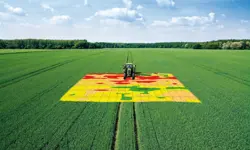
Precision farming
Technologies such as global positioning systems and guided vehicles are being developed to create an era of precision farming. Professor Richard Godwin FREng explains how these initiatives can combine accuracy and control of field operations leading to increased efficiency and yields.
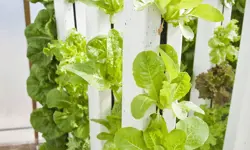
Farming straight up
Hydroponics, growing plants without soil in nutrient-enriched water, is a technique that has been used in some form for centuries. As the global population grows and food security is threatened, its faster growth and larger yields have become increasingly important.
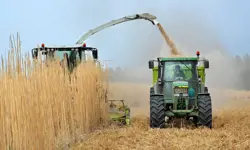
What role for biofuels in low-carbon UK transport?
Biofuels have a role to play in meeting the UK’s climate change commitments. Sustainable Chemical Engineering Professor Adisa Azapagic FREng sets out why biofuels made from wastes and by-products in different sectors are particularly important to these efforts.
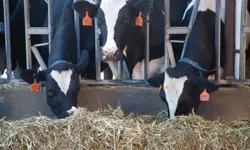
The automation of dairy farms
Robotic milking is not a new innovation, but the systems are increasingly being adopted by UK dairy farms. Science writer and broadcaster Geoff Watts learned from John Baines, Technical Director at Fullwood, how these systems are being engineered to do more than just milk cows.
Other content from Ingenia
Quick read

- Environment & sustainability
- Opinion
A young engineer’s perspective on the good, the bad and the ugly of COP27

- Environment & sustainability
- Issue 95
How do we pay for net zero technologies?
Quick read

- Transport
- Mechanical
- How I got here
Electrifying trains and STEMAZING outreach

- Civil & structural
- Environment & sustainability
- Issue 95